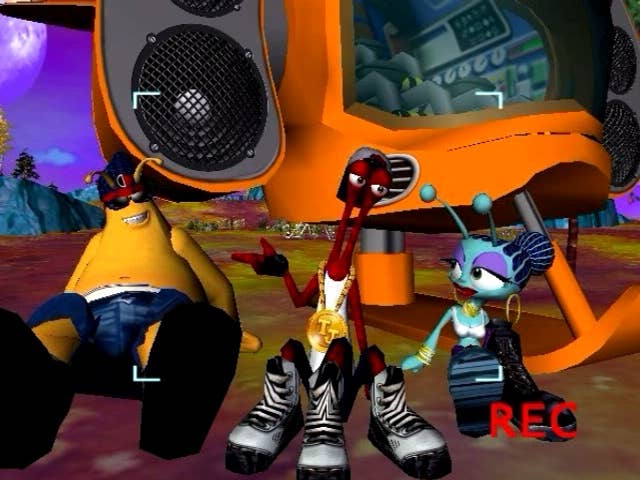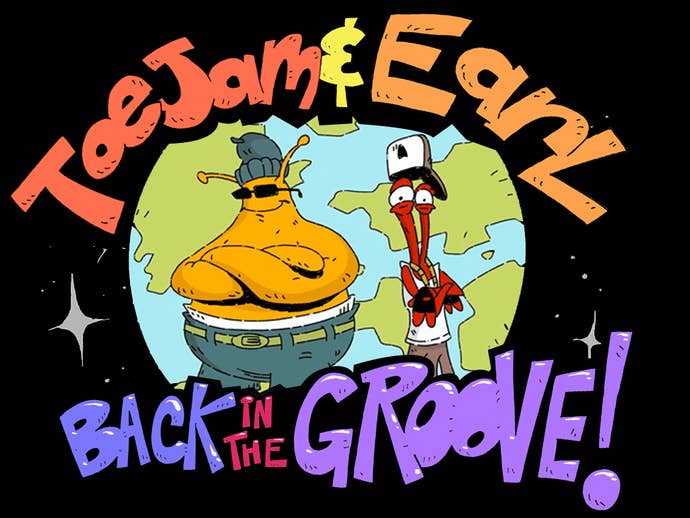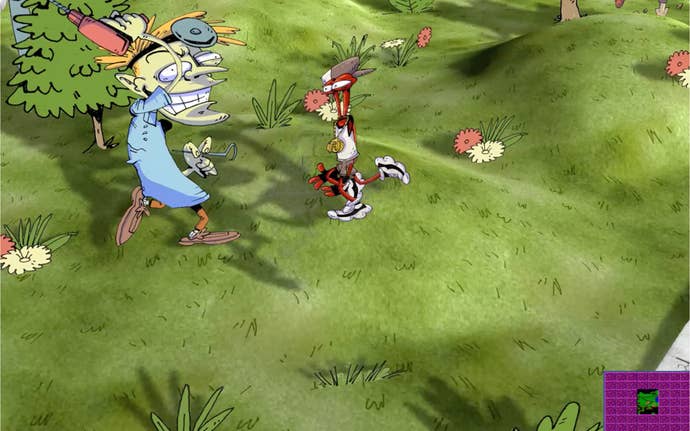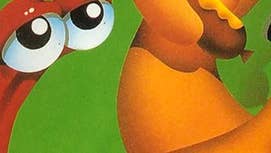The Return of ToeJam & Earl, the Genesis Exclusive Time Forgot
With another ToeJam & Earl on the way, we examine the Sega franchise time forgot.
This article first appeared on USgamer, a partner publication of VG247. Some content, such as this article, has been migrated to VG247 for posterity after USgamer's closure - but it has not been edited or further vetted by the VG247 team.
ToeJam & Earl is one strange franchise. Massive changes have been the dominant theme of each of its three incarnations (and that's ignoring the light-gun spinoff Ready, Aim, Tomato), leaving little continuity other than its funky-fresh vibe and space-faring stars. Its many faces make it all too easy to single out one game as your favorite while quietly forgetting the others even exist.

But each does have worth. Those divisive overhauls of every game mirror what had been going on during that time in the industry at large. With a new entry underway—which has a Kickstarter set to go live this week—it's time to place this shape-shifting franchise in the proper context.
ToeJam & Earl
Oh sure, you may be fully versed in all things roguelike, but in 1991, they were unheard of in the console world. When ToeJam & Earl landed, it was like a funky meteorite had forever shaken the gaming landscape. The two smooth world travelers strutted across a strange land (read: Earth) populated by all manner of weirdos (read: earthlings) on their way to reassemble their broken ship, all while a ripping baseline wormed its way into your head and down your dancing legs.
The foundation was built upon what Rogue had started years earlier, but with so many changes that it was nigh unrecognizable as an homage without a PhD in gaming history. The first shift was in the aesthetics. This is one happy game. The characters, enemies, and even the items you collected were all infused with a healthy sense of humor, which is a great way to distract you from how bloody hard the game could be. Color goes a long way toward accessibility, and that's exactly what ToeJam & Earl was gunning for.
You see, roguelikes were (and still are) incredibly difficult. But ToeJam & Earl was different. This was a game that your father could play with you, or even your grandmother if her eyes were still sharp. That's because pretty much all you could do was walk around. You'd cruise across the green countryside in search of presents to collect and earthlings to avoid. Just relax, listen to the soothing tunes, and let Earl's sweet fart jokes bring a smile to your lips. Without any need for dexterity, or even much strategizing, it was a game you could play with slow fingers and a slower mind.
Another marked shift from its progenitor? Combat. Read the above description once more. Do you see "fighting" mentioned anywhere? That's because hand-to-hand fisticuffs are an earthlings disease, not something chill aliens have much interest in. When danger would approach, instead of readying your aim, you'd instead turn tail and mosey away. Imagine that, a game that encourages non-violence.
Now, that's not to say Earl and his three-legged buddy were pacifists. Those presents you're collecting? They give you temporary items. And two of them involved the power to chuck tomatoes. Yes, even when you turned your aggression against the earthlings, things more closely resembled a bad vaudevillian performance than a typical video game showdown. If you happened to splash a couple tomatoes on a nerd herd or hula dancer, they'd disappear with a mild pop, as if they never existed at all.
One place that ToeJam & Earl fully embraced its inspiration was in its randomness. No two playthroughs were alike. The levels would morph in fun and unexpected ways every time you fired the game up, and even the presents you collected had a surprising use each time. You were never sure which box hid the rocket skates and which the total bummer (which took one of your precious lives away), so you opened them at your own risk. No matter the results, it was always exciting, even if you just got a bottle of rootbeer and a bad case of the burps.
ToeJam & Earl in Panic on Funkotron
Remember when I said that ToeJam & Earl was divisive? Here's where that idea was planted. Just two years after the seminal original came a sequel that put a finger on its nose and delivered a hearty Bronx cheer. Yeah, it still has funk, earthlings, and an emphasis on co-op action, but it lacked that certain je ne sais quoi. Oh, for those who don't speak French, je ne se qua means "They made it a side-scroller!"
It's amazing how much impact a perspective shift can have. ToeJam & Earl stood out, in part, because it offered an overheard point-of-view (in a free-to-explore open world) amid a sea of games that wouldn't recognize the z-axis if it threw a pie in their face. And then here comes the sequel, prancing in like no one would notice that it's got a whole new look. You could see a rift carve right through an expectant fanbase. Some put on a pout face, mimed an exaggerated yawn, and went back to their comforting original. Others gobbled up Panic on Funkotron like it was a fudge sundae from the gods of funk.
Even though the all-new look is the most obvious difference between Panic on Funkotron and the original, the changes go much deeper than that. Every point in gaming history is marked by an influx of one or two styles of games. In the '90s, that was platforming, and Panic on Funkotron leaned hard on its many, many, many peers for inspiration. You see, this was an alien-jumping, foe-fighting, action-packed adventure in which you could easily picture an in-your-face commercial advertising its baditude with an angry man screaming "Sega!" at the end.
Remember how ToeJam & Earl did little but walk slowly in the original game? They must have gotten a packet of rocket powder dumped down their pants in the sequel. They leapt around like any good video game star, taking on precise jumps that grandma wouldn't have a chance at landing. And the passiveness that separated ToeJam and Earl from their earthling harassers in the original had been flipped on its head here. Now you're the instigator. Sure, the fact that those humans snuck on your ship to inhabit your home planet isn't ideal, but they're just annoying tourists; no need to trap them all in bottles. ToeJam and his rotund sidekick seem like the kind of guys who would try to hang with the dweebs and bullies, not send them back home in a glass prison.
History has not looked kindly upon the schism that separated ToeJam & Earl from Panic of Funkotron, but that's not entirely fair. Panic on Funkatron was still loads of fun, just in a more traditional way than it's out-there predecessor. In fact, you can even see why some prefer the outing that takes place on ToeJam's home planet. As exciting as ambling can be, pogoing furiously around a psychedelic land has its own unmistakable charm.

ToeJam & Earl III: Mission to Earth
Now here's where things got really interesting. Coming a decade after Panic on Funkotron, Mission to Earth had years of people's scattered opinions to sort through. Some preferred the laid-back adventuring of the first, whereas others inhaled the chaotic exuberance of the sequel. Surely, there must be a way to satiate both groups, while adding a few new pieces to the jigsaw puzzle. Well, Mission to Earth attempted just that, but ended up being forgotten anyway.
Structurally, the game bore a strong similarity to ToeJam & Earl. The open-world, explore-until-you-drop heart thumped strong and proud. Randomized levels could be unlocked once you completed a stage once, injecting more variety than any one person could possibly stand. You could take things slow, take a deep breathe, and enjoy the surreal sights. It was like being transported to the Genesis era, except with much better visuals.
And for those who craved more Panic on Funkatron, there was plenty of contagious energy thrown into the mix. Movement was much so joyful, encouraging you to leaving the walking stick behind while you stretch your legs for some excitement. Presents from the original game returned with a modernistic overhaul. The Icarus wings that seemed so thrilling in the '90s (but were slow and cumbersome in reality), were given new life in Mission to Earth, empowering you with previously unheard of locomotion.
Surely, this must have been the best of both worlds. Why, then, has it been lost in the ether? Well, just like platformers were all the rage in the '90s, the early aughts had a trend of their own. Every console had complicated controllers that would make anyone older than, say, 50 years old faint. "Those kids and their newfangled contraptions" could be heard echoing from every retirement home. Games became more and more complex, keeping pace with the two sticks and ten buttons that were within reach of everyone's fingertips. And Mission to Earth was hurt by this trend.
Every minute, another activity distracted you from simple exploration. Maybe you'd have to tap out a rhythmic beat, listen to the choir belt out another hymn, or funkopotomus knows what else. Taken on their own, such deviations would have been fine. But Mission to Earth had layers upon layers of needless activities, serving as a reminder that less is most definitely more.
Still, Mission to Earth deserved more respect than it got. It was bloated, yes, but still so novel and endearing that it should have made a bigger impact. Part of the problem was the lone console that it appeared on. The Xbox wasn't exactly known as a beacon for catoony, happy-go-lucky adventures, after all, so maybe the funkiest aliens in the galaxy would have had a better chance with a more receptive audience. Who knows? But Mission to Mars was so close to being what people wanted, and yet still so very far away.

ToeJam & Earl: Back in the Groove
Which brings us to the next iteration. I've had a chance to see an early build of Back in the Groove, and speak to its small development team, and it's definitely headed in the right direction. This is a return to the original's ideals, spouting an overhead perspective, loads of randomness, and an emphasis on non-violent resolutions. The creeping complexity of the last two games has been scaled back to welcome in the spouses, friends, and family members that can't handle the reflex-heavy demands of the modern era.
Even though everyone should be able to enjoy the game, it doesn't ignore those who have fond memories of the last two games. Walking is still the predominant form of movement, but if you want some excitement, Back in the Groove has you covered. One of your abilities is to terraform the ground. Just cause a hill to rise from the earth and then use your rocket skates to catch some serious air. If the game can include exciting events such as that while still staying true to the accessible exploration of the original, then we may have something special to look forward to.

This seems like the game I have been waiting more than 20 years to play. As much as I loved the first game, we've entered a new era, so a straight remake would fall flat. Borrowing bits and pieces from throughout the franchise's history could inject new life into an old game. I'm exciting, there's no doubt about that, and yet, it's impossible to not have some doubt. ToeJam & Earl is so magical, so timeless, so nestled in my ten-year-old mind as the pinnacle of gaming, that it's hard to believe it can ever be topped.
But there's nothing that could stop me from playing Back in the Groove. Even in the rise in popularity of roguelikes, there's never been anything like ToeJam & Earl. The world is ready for a roguelike markedly different from what's currently out. Give us one with a comedic slant, that makes light of a genre that has been the domain of the hardest of the hardcore. I would love to show my wife who doesn't play games a piece of my childhood with a modern veneer. And that's why I have so much hope whenever another entry comes around. The history of this franchise shows how hard it is to capture gold, but there's always a chance. Let the funky time roll.











